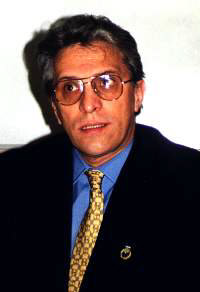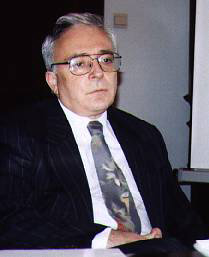
|
| |

|  Romania Romania
the awakening giant of Europe |

 Looking for lost prosperity - 1997 : A mixed performance - Rebuilding the Country - Looking for lost prosperity - 1997 : A mixed performance - Rebuilding the Country -
Major Infrastructure Projects March On - The Tough Game - No Pain, No Gain -
The Young Wolves of the Private Sector - What's Next? 
 Rebuilding the Country Rebuilding the Country
The gradual transition promoted by the former governments preserved almost unchanged many of the specific structures - institutional, economical, and administrative - inherited from the communist era. The large, change adverse and very well entrenched bureaucracy proved to be particularly annoying, most foreign investors considering it as the main obstacle against an investor-friendly business environment.
One of the not that visible -- yet extremely important -- changes that are taking place in Romania is the institutional reform that should be the very basis for the economic reform.
"When we talk about the need for structural reforms, we mean on one side the institutional reforms, building up the set of institutions that define a market-based economic system and a democratic society, a state of law," says the charismatic Minister of Finance, Mr. Daniel Daianu .

Daianu, formerly chief economist with Romania's central bank, is another technocrat appointed late last year.
Part of this institutional reform, the liberalization of prices is a process that began in
1990. It was perhaps the ultimate reason that determined the ousting of then-prime minister Petre Roman : "I agree with the international experts when they say that had the Romanian reforms continued the way we started in 1990, we would have been now at least at the level of our neighbors." Various economic, social, and political interests delayed the full liberalization for years. It was only by March last year that prices have been fully liberalized. Prices of a few very basic products and services (electricity, natural gas, thermal power, several basic food products) do still benefit by a transparent and limited system of subsidies. It was a step welcomed by all analysts, who had hard times trying to valuate companies that do not even know their cost structure. Many such companies -- especially those where energy accounts for a large share in the cost structure -- had shown nice profits in their books only due to the heavily subsidized price of energy. By April this year the prices of electricity and natural gas will double, reducing the gap between the market rates and what the populace pays. Companies are operating in a price environment that is fully liberalized. Their electricity bills are actually slightly overcharged, as corporate customers subsidize household consumption.
By and large, both the stock exchange and the over-the-counter market have been success stories of the transition period. The stock exchange and the regulatory body, the National Securities Commission (CNVM) were established (actually re-established, after half a century break) in November 1995, and they enjoyed extensive British and Canadian technological and know how support. 92 companies are currently listed on the two tier stock exchange. The over-the-counter market -- that got the not particularly original name of RASDAQ -- began trading by the fall of 1996. Obviously, it is organized after NASDAQ's model, by means of USAID-funded assistance. Over 5,500 companies are being traded on RASDAQ.
However, likely the most significant development within the institutional reform area was the setting up of the Privatization Ministry. The new structure concentrates several bodies formerly independent -- including the State Ownership Fund (SOF ), whose main roles are to sell state's stakes in thousands of companies and tomanage those companies until they are sold.

The ministry also includes a department made of the former Romanian Development Agency, an organization that deals with foreign investments. The new ministry will hopefully help rationalizing the area of privatization, speeding up the process of state's divestment in commercial companies and cutting some of the overwhelming red tape. This Ministry was created to act as a strategy and policy making institution with respect to privatization. It makes for the first level of public institutions involved in privatization. The second level is the SOF, subordinated to the ministry. Its legal status -- as mentioned in the new law of privatization -- is that of a non-typical closed-end fund. This structure is accompanied by a set of specific laws -- regarding leasing, franchising, the commodities exchange -- aiming at putting in place a new economic system, a capitalist system that would create resources without any intervention of the state.
| Romania's pledge for full membership of the European Union has had effects in other areas of the institutional reform as well. The competition legislation and the bodies that are in charge with these issues (the Competition Office and the Competition Council) were set up during the last two years and are very much aligned to the European standards.
By the first week of March 1998 the legal framework that regulates the banking industry in Romania was almost completed. The bank privatization law opened the show almost one year ago, when it was approved by the Parliament with an overwhelming majority that few other laws enjoyed ever since. Both chambers of the Parliament approved later the law on the commercial banks. It enforces the European concept of universal banking, with few restrictions regarding banks' operations on the capital markets. The third law in the package concerns the statute of the central bank and assigns it as the monetary authority, with first hand role in controlling the money supply, curbing inflation and drafting the exchange rate policy. Finally, the bill on bank insolvency cleared the Senate few weeks ago, after being approved by the Lower House last year. It provides for a fast insolvency decision if a bank ceases payments for more than 30 days, or if its liabilities exceed assets.

The Governor of the National Bank of Romania , Mr. Mugur Isarescu is keen to underline the importance of the reforms the central bank went through: "What we need are strong institutions, with good reputation, and this institution is going to be one of them. Our most important goal in the '90s was to transform the National Bank of Romania into a central bank of the modern world. We became an independent institution, subordinated to the Parliament, not to the cabinet. The central bank has to be politically neutral and we put this in the law. We got rid of the commercial activities, and built from ground zero the monetary policy, the interest rates policy and the reserve requirements, refinancing of the commercial banks, the payment system and the clearing house, the supervision, licensing and regulation departments. The exchange rate policy is also our responsibility. This is nothing to be proud of, because having such a large scope of activities also means a large responsibility and vulnerability -- but that is what we have developed."
Perhaps central bank's biggest success in 1997 was the full liberalization of the foreign exchange market in February. The monopoly of the four market maker banks -- three of them state-owned -- was broken. Over 30 banks compete now on this market and the exchange rate is set on the basis of the demand and supply law. The overall volume of daily transactions more than doubled to some $40 million as against the previous level. The market got a liquidity never reached before. Old time queues, with corporate customers waiting for weeks or months in order to get the hard currency they need, are relics of the past. The central bank intervenes on the market with the only purpose of controlling the money supply.
Given the weak absorption capacity of the Romanian economy, the central bank had hard times trying to both accommodate the large capital inflows that entered the market last year and to sterilize the Lei equivalent of the $2 billion it piled in just a few months in the state's currency reserve. The smooth operation of the forex market and the $2.6 billion cash cushion of the foreign currency reserve were among the most significant incentives that prompted the National Bank of Romania to make a decision of truly historical value: by the end of January 1998 Romania accepted the article VIII of the International Monetary Fund's statute, and the Romanian currency, the Leu, became convertible for current account operations. What many feared -- a panic on the market, with the savings of the population rapidly converted into hard currencies, speculators stepping in, with the final outcome of a steep depreciation of the domestic currency -- did not happen. The transition was unexpectedly smooth. "I do believe that this move was one of the most powerful positive signals Romania sent to the foreign investors," comments Isarescu. |
© World INvestment NEws, 1998.
This is the electronic edition of the special country report on Romania
published in FORBES
Magazine's enriched with complementary information,
such as full interviews, detailed company files and more.
June 1 st 1998 issue
Developed by AgenciaE.Tv |
|
|
|
| |
| | | |
|

